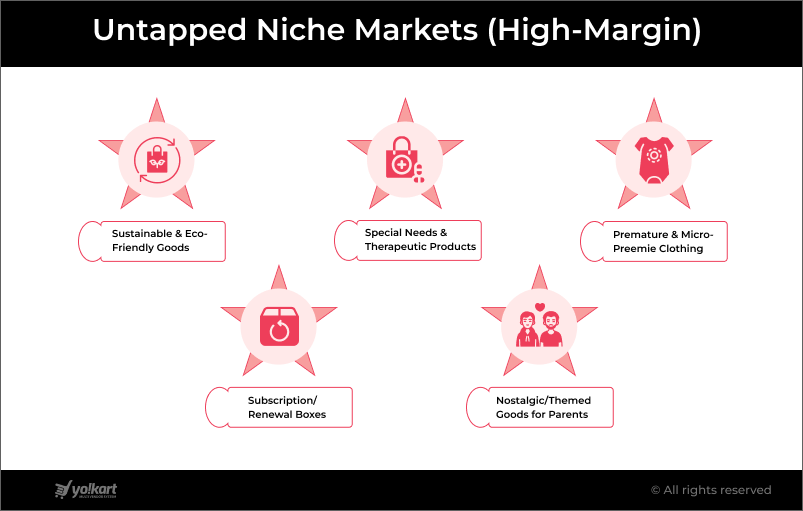Published date 06th Nov 2025
The baby and kids’ product sector is not just an industry; it’s a global phenomenon driven by the primal impulse of parental love. With parents increasingly prioritizing safety, quality, and convenience, this market segment has become one of the most resilient and lucrative areas in the eCommerce market. Furthermore, as per a report of Grand View Research, the global baby products market size is projected to reach $475.15 billion by 2030, growing at a CAGR of 5.9% from 2024 to 2030.
However, selling a wide range of goods, from sensitive baby formula to regulated child safety seats, presents unique logistical and trust challenges that a standard single-vendor eCommerce store simply cannot meet. This is where the power of a multi-vendor marketplace shines. By aggregating diverse, specialized sellers under a single trusted brand, a marketplace can offer an unparalleled selection while ensuring adherence to the highest standards.
Hence, this comprehensive blog will provide a deep understanding of the modern parents’ needs to visionary entrepreneurs and businesses looking to create a marketplace for baby & kids products.
Table of Contents
- The Business Model of a Baby & Kids Product Marketplace
- Top Categories and Emerging Niches in Baby & Kids Products
- Untapped Niche Markets (High-Margin)
- Successful Baby & Kids Product Marketplaces Globally
- Things to Consider Before Creating Your Marketplace
- How to Create the Marketplace: Choosing Your Development Path
- Tips to Market Your Marketplace and Attract Parents
- Yo!Kart: Ready-made Software Solution to Build Your Baby & Kids Product Marketplace
- Conclusion
The Business Model of a Baby & Kids Product Marketplace
The multi-vendor marketplace model is highly appealing because it scales without proportional inventory risk. Instead of buying and stocking products, the platform acts as the trusted mediator, generating revenue primarily through seller interactions.
In the baby and kids’ product niche, this model proves especially effective, enabling parents to access diverse, verified products from multiple sellers in one place. A baby and kids’ product marketplace can generate revenue through multiple streams, such as commissions, subscriptions, featured listings, and advertising. By leveraging these strategically, marketplace owners can achieve sustainable growth while helping vendors reach their target audience more effectively. Let’s explore some of the most common revenue streams below:
Primary Revenue Streams
- Commission-Based Model (The Core): This is the most common and robust model. The marketplace charges a percentage commission on every successful sale made by a vendor. This aligns the platform’s success directly with that of its sellers. However, commission rates are often tiered based on product type, for instance, lower for high-volume essentials like diapers and baby wipes, and higher for premium items such as organic skincare, handmade toys, or strollers.
- Example: A 10-20% cut on all transactions.
- Example: A 10-20% cut on all transactions.
- Subscription/Membership Fees: Vendors pay a recurring fee (monthly/annually) to maintain a storefront on the platform. This helps cover the administrative and hosting costs and is a stable, predictable revenue stream.
- Tiers: Basic, Pro, and Enterprise tiers can offer differing levels of support, listing limits, and premium features (e.g., advanced analytics).
Similarly, subscription plans can be introduced for customers, such as “Parent Plus”, which includes perks like free delivery, early access to sales, or curated parenting bundles.
- Featured/Premium Listings (Advertising): Sellers pay an extra fee to have their products or their entire storefront highlighted in prime locations, such as the marketplace homepage, category pages, or during seasonal campaigns (baby showers, back-to-school), or within curated gift guides.
- Value-Added Services: Offering services like fulfillment (marketplace-managed logistics), professional photography, eco-friendly packaging, or even third-party compliance verification can be packaged and sold to vendors for additional revenue. Additionally, compliance checks for baby safety standards can be monetized as part of seller onboarding.
- Gift Registries & Event Partnerships: Create monetized baby shower or birthday registry programs where vendors pay for featured inclusion or promotional placement within event-specific collections.
The Value Proposition: Trust and Variety
The key to a successful baby & kids’ marketplace lies in the value proposition you offer to both sides of the transaction:
| Stakeholder | Core Need | Marketplace Value Proposition |
| Parents (Buyers) | Trust & Safety | Curated selectionMandatory safety certificationsConsolidated product reviewsA single, secure checkout. |
| Vendors (Sellers) | Reach & Simplification | Instant access to a high-intentTargeted audiencePre-built eCommerce infrastructureOutsourced marketing/SEO. |
Top Categories and Emerging Niches in Baby & Kids Products
A successful marketplace for baby and kids’ products must cater to established high-demand sectors while actively seeking out lucrative, low-competition niches. Moreover, the baby and kids’ market is constantly evolving, driven by shifting parental priorities, making it essential to balance popular product segments with innovative offerings that address emerging needs and create a distinct competitive advantage.
Top Established Categories (High-Volume)
These foundational categories drive continuous, high-volume sales:

- Feeding & Nutrition: Includes formula, organic baby food, bottles (anti-colic, BPA-free), high-chairs, and specialized weaning tools.
- Safety & Gear: Car seats, strollers, baby carriers (especially ergonomic designs), playards, baby monitors (smart/Wi-Fi enabled), and essential safety gates.
- Apparel & Personal Care: Diapers (disposable and cloth/reusable), wipes, skin care products (hypoallergenic, chemical-free), and clothing (newborn to toddler sizes).
- Nursery Furniture: Cribs (cots), changing tables, mattresses (must meet strict local safety standards), and gliders.
- Toys & Educational Products: Age-appropriate toys, sensory items, and early-learning educational kits.
Have a Unique Business Idea for Baby and Kids’ Marketplace
Untapped Niche Markets (High-Margin)
To truly build a marketplace for baby & kids products that stands out, target these specialized, high-margin niches where parents are willing to pay a premium:

- Sustainable & Eco-Friendly Goods: This is a major trend. Focus on certified organic apparel, reusable silicone products, biodegradable diapers, and non-toxic wooden toys. A platform specializing only in ‘Green Parent Certified’ items has an excellent niche brand identity.
- Special Needs & Therapeutic Products: Gear and toys designed for children with sensory processing disorders, autism, or physical disabilities (e.g., specialized seating, weighted blankets, quiet-time sensory kits). This market is currently underserved.
- Premature & Micro-Preemie Clothing: A hyper-niche focusing on apparel for babies born early. Parents often struggle to find safe, comfortable options in standard stores.
- Subscription/Renewal Boxes: Curated, recurring delivery of age-specific essentials (diapers, wipes, baby food) or educational/activity boxes for toddlers. This creates an extremely sticky, high-LTV (Lifetime Value) customer base.
- Nostalgic/Themed Goods for Parents: Products that appeal to the aesthetic tastes of the parents (e.g., the trend of retro 80s/90s designs for teething toys or clothes) can create significant social media buzz.
Successful Baby & Kids Product Marketplaces Globally
Examining successful global players reveals two core strategies: broad dominance and deep specialization. Thus, analyzing these leading players provides valuable insights for building a competitive, scalable marketplace. Hence, let’s have a look at some of the top players of the baby and kids’ products marketplaces:
- Babies “R” Us (USA/Global): A classic example of a large-format specialist. While it faced challenges in the past, its resurgence demonstrates the continued power of a trusted, focused brand in the baby sector, particularly for high-value items and essential registry services. Their value lies in an enormous, curated selection.
- Etsy (Global – Focused Niche): While not exclusively a baby marketplace, Etsy’s success in the kids’ sector, particularly for handmade, personalized, and small-batch items, including unique nursery décor, custom clothing, and personalized gifts, proves the strong demand for goods that mass-market retailers cannot provide. Their model is all about supporting micro-entrepreneurs and uniqueness
Suggested Read: Build an Online Marketplace Like Etsy | Etsy Clone Script
- Gummy Chic (USA – Specialist Innovators): It is a smaller, highly-focused brand that gains recognition by solving a specific parent problem with innovation, such as stylish, therapeutic teething/sensory products, and more, validating the power of a strong niche within a larger marketplace ecosystem.
Build an Etsy-Like Marketplace for Baby and Kids’ Products
Things to Consider Before Creating Your Marketplace
The paramount concern in this sector is trust. Unlike selling general consumer electronics or clothing, a faulty baby product can have severe consequences, placing a massive legal and ethical burden on your platform. Thus, it becomes crucial to focus on the factors mentioned below:
1. Safety, Quality, and Compliance (Non-Negotiable)
- Mandatory Vendor Vetting & Certification: Your marketplace must implement a zero-tolerance policy for non-compliant products. For instance, in the US, compliance with the Consumer Product Safety Improvement Act (CPSIA) is crucial. You must require sellers to upload the Children’s Product Certificate (CPC) for all regulated items.
- Chemical & Material Safety: Enforce strict standards against harmful chemicals, such as BPA-free plastic and phthalate-free toys. Require vendors selling apparel to certify the use of non-toxic dyes and organic materials where claimed.
- Proactive Recall Management: Establish a robust system to instantly flag and delist any product that has been subject to a manufacturer’s recall. Trust is gained by being the first to inform a customer about a potential safety issue.
- Detailed Product Information: Product pages must include exhaustive details, including material composition, safety testing results, country of manufacture, assembly instructions, and clear age grading.
2. Parent-Centric User Experience (UX)
- Age-Grading & Filtering: Since the user’s needs change monthly (or even weekly) in the first year, advanced filtering by age/stage (e.g., ‘6-12 Months,’ ‘Teething,’ ‘Potty Training’) is more critical than standard product category filters.
- Registry & Gifting: A seamless, high-functioning baby registry feature is a major driver of traffic and sales. Additionally, gifting options should include gift wrapping, personalized notes, and easy one-click purchases.
- Community & Reviews: Allow for deep, honest product reviews and Q&A features. Parents rely heavily on peer experiences. Consider integrating a ‘Verified Buyer with Kid’s Age’ tag for added credibility.
3. Logistics for Diverse Products
- Oversized Item Shipping: The platform must support shipping for large items (cribs, strollers) with separate rates and specialized carriers.
- Perishable/Time-Sensitive Goods: If selling formula or fresh baby food, your platform must support fast, potentially refrigerated, shipping options from localized vendors.
- Returns Policy: While returns on certain items (like formula) may be restricted, the general return policy must be flexible and clearly communicated, as parents often purchase multiples or change their minds rapidly.
How to Create the Marketplace: Choosing Your Development Path
Launching your baby and kids’ marketplace requires a structured approach. Given the high-risk, regulatory-heavy nature of this market, your platform must be secure, scalable, and feature-rich. Thus, selecting an approach that balances operational needs and prioritizes robust features becomes critical for long-term success.
However, fundamentally, there are two paths to create your eCommerce marketplace for baby and kids’ products:
A. Custom Development (Build from Scratch)
This approach involves hiring a team of developers, designers, and project managers to build the platform line-by-line, tailored exactly to your unique specifications. While it allows for complete creative freedom and the integration of specialized features, it also demands a significant financial investment and extended development time before launch. Hence, it can significantly delay your time-to-market.
| Pros | Cons |
| Complete Control: Total ownership and full control over every single feature and integration. | High Cost: Extremely high initial investment (often $100k – $500k+ for an MVP). |
| Unique Features: Can build highly specific, proprietary tools (e.g., an AI safety checker). | Slow Time-to-Market: Development cycles can take 12-24 months or more, delaying revenue generation. |
| Ultimate Scalability: Built to your precise future needs without platform limits. | High Maintenance Burden: You are solely responsible for all bug fixes, security updates, and technical maintenance. |
B. Ready-Made Solutions (The Smart Start)
This involves purchasing a pre-built, licensed multi-vendor marketplace software solution. This type of solution comes equipped with core features, such as vendor management, payment splitting, product listings, and more, required to launch a multi-vendor marketplace. Unlike custom development, it enables a faster, more cost-effective launch with minimal technical complexity. Additionally, such solutions are continually updated for security and performance, allowing you to focus on business growth rather than backend development.
| Pros | Cons |
| Speed to Market: Can launch an MVP (Minimum Viable Product) in weeks or months, not years. | Learning Curve: Adapting to the system’s predefined workflows can also involve a slight learning curve, especially for teams new to marketplace operations. |
| Lower Cost: Significantly reduced initial investment and maintenance costs. | No Control Over Tech Stack: Since the platform’s technology stack is pre-defined, businesses have limited flexibility to choose or modify underlying technologies. |
| Proven Stability: The software has been tested and refined by many other marketplace owners. | – |
| Ongoing Support: Updates, security patches, and bug fixes are usually managed by the software vendor. | – |
Recommendation: For the Baby & Kids market, where time-to-market, core functionality (vendor management, payments), and security updates are critical, leveraging a readymade multi-vendor solution is the most efficient and sensible path. It provides the robust backbone necessary for compliance and rapid growth.
Example of a licensed, ready-made solution: Yo!Kart
Looking for a Reliable Readymade Solution for Your Multi-Vendor Baby Product Marketplace
Tips to Market Your Marketplace and Attract Parents
Marketing to parents requires an emotional connection built on shared values and convenience. Highlight safety, quality, and ease of use, provide valuable content, and leverage social proof. Additionally, engaging parents through personalized experiences, community interactions, and targeted campaigns drives loyalty and long-term marketplace growth.
1. Build a Trust-Centric Content Strategy
- Safety Hub: Create a prominent content section (a blog or “Safety Zone”) that acts as an authoritative resource for parents. Publish articles on safety standards, product recall news, and tips for choosing age-appropriate items. This positions you as an expert, not just a seller.
- Leverage User-Generated Content (UGC): Encourage parents to post photos and videos of their children using the products. This content is highly authentic and acts as powerful social proof.
- Focus on Stage, Not Just Age: Market products using life stages (e.g., “First Solid Foods,” “Toddler Independence,” “Back-to-School Readiness”) rather than generic age ranges.
2. Optimize for Local and Social Discovery
- Local SEO & Vendor Mapping: Optimize the platform for local searches (e.g., “organic baby food delivery [City Name]”) if you offer localized fulfillment options from your vendors.
- Engage on Instagram & Pinterest: These are visual platforms where parents seek inspiration for nurseries, clothing ideas, and themed parties. Use high-quality lifestyle imagery and run targeted ads to recent parents based on demographics and interests.
- Parenting Community Partnerships: Collaborate with popular mommy bloggers, pediatric influencers, and local parenting Facebook groups to run exclusive discounts and giveaways. Word-of-mouth is gold in this sector.
3. Maximize Customer Retention (LTV)
- Personalized Recommendations: Utilize analytics to offer cross-sells based on the child’s age, development stage, and past purchases (e.g., a customer who bought a crib should be shown toddler beds 2 years later).
- Loyalty & Rewards Program: Implement a system where repeat purchases unlock discounts, early access to new products, or free expedited shipping, incentivizing a habit of returning to your platform for every stage of the child’s life.
Yo!Kart: Ready-made Software Solution to Build Your Baby & Kids Product Marketplace
Creating a marketplace for baby and kids’ products comes with unique challenges such as strict safety regulations, sensitive product categories, and the need to build trust among parents. To overcome these, the chosen solution should offer seamless seller onboarding, verification, and product approval processes. Yo!Kart, a dedicated multi-vendor ecommerce software, is one such solution that addresses these challenges with features built for reliability and compliance. Other than this, it allows platform owners to give category-based product approvals to ensure only certified items like toys, baby formula, and gear are listed. Moreover, Yo!Kart enables a safe, user-friendly, and globally scalable shopping experience that builds parental trust and long-term brand credibility in the baby and kids’ product marketplace.
Key Features of Yo!Kart
Yo!Kart offers a suite of features essential for managing the high-stakes, high-volume environment of the baby and kids’ product market:
- Dedicated Vendor Management Panel: Provides a separate, intuitive dashboard for each seller to manage inventory, update product listings with compliance documents, monitor orders, and view performance reports without needing direct access to the marketplace backend.
- Automated Commission Management: Features a built-in revenue stream configuration system that automatically calculates the platform’s commission, seller’s share, and affiliate payouts, ensuring transparent and hassle-free payment splitting.
- PWA (Progressive Web App) Development: Provides the capability to launch a fully responsive, app-like mobile experience instantly. This is vital for busy parents who predominantly shop via their smartphones.
- Multi-Lingual and Multi-Currency Support: Essential for global expansion or serving diverse local populations, allowing customers to shop and pay in their native language and currency.
- Scalability for Growth: Being a licensed/self-hosted solution, it offers the freedom to fully customize the source code and scale the platform without restrictive transaction limits, making it a future-proof investment as your marketplace grows from a niche hub to a global contender.
- Integrated Marketing Tools: Includes features for setting up discounts, running flash sales, managing loyalty points, and generating SEO-friendly URLs and sitemaps-tools crucial for driving traffic with targeted keywords like create a marketplace for baby products.
By opting for a solution that covers these critical multi-vendor functionalities, you can focus your time and resources on vendor curation, safety enforcement, and branding as the true differentiators in the baby and kids’ market.
Book a Free Personalized Demo to Explore Yo!Kart
Conclusion
Creating a marketplace for baby and kids’ products is more than a commercial venture; it is a commitment to the well-being and safety of the youngest generation. Success hinges on a foundation of uncompromising quality and trust, supported by an efficient, highly scalable eCommerce marketplace software.
By carefully defining a strong niche, establishing rigorous safety vetting for all sellers, and leveraging the emotional and informational needs of modern parents in your marketing, your platform can move beyond simply selling products. It can become the indispensable, trusted resource that parents turn to for every milestone of their child’s growth.




